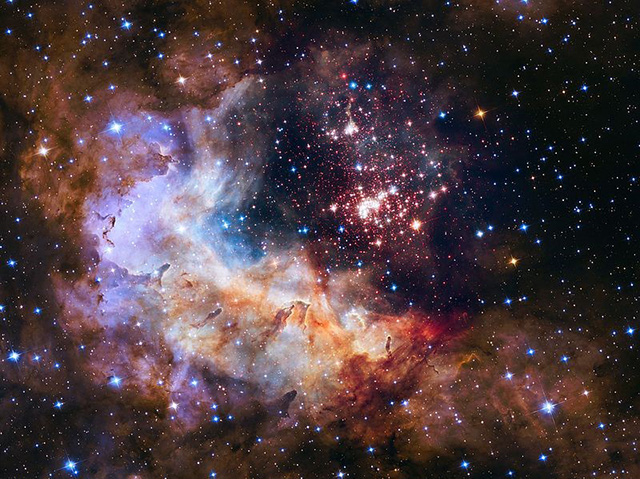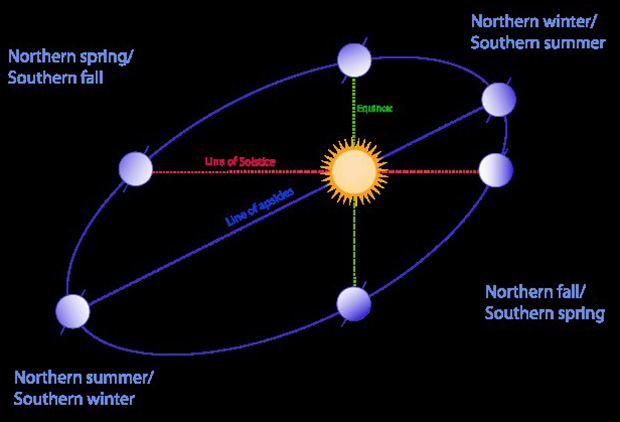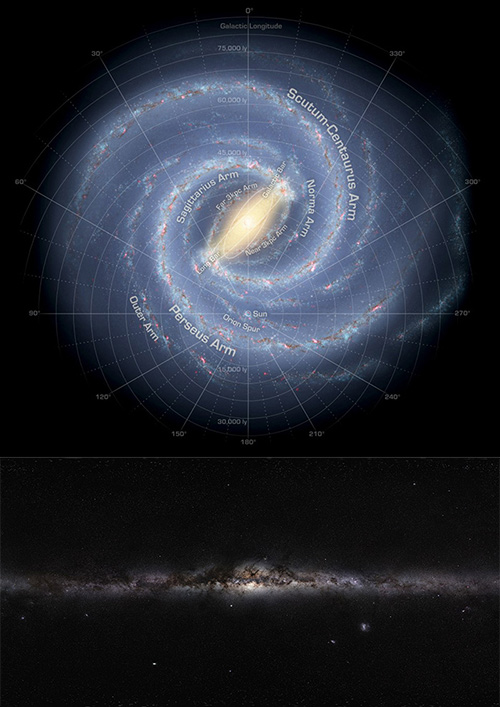
At midnight, at the end of the year, Earth celebrates the completion of two cycles.
The first, of course, is Earth’s rotation, turning day to night and back again.
To complete this cycle, Earth rotates at 1,000 miles an hour, counterclockwise.
Not all planets spin this way. Venus rotates the opposite direction, and Uranus spins at 90 degrees to its orbit.
But pretty much everything in the universe spins.
The second cycle of course, is Earth orbiting the sun. The Solar System began as a cloud of dust and gas spinning around the sun 4.6 billion years ago, and should keep spinning for a few billion years more.
This rotation of Earth around sun is even faster: 67,000 miles an hour, and it takes 365-and-a-quarter days. This was recognized and set into a calendar by the Romans, but they overlooked that extra quarter day.
Meaning that, by the late 1500s, the calendar had drifted 10 days off. At that point, Pope Gregory added a leap day every 4 years, and the modern calendar was born.
Our Solar System is moving, too, and faster still. It’s in the Orion arm of the Milky Way galaxy, which orbits a supermassive black hole at 600,000 miles an hour.
And the black hole is spinning, too, even faster—more than 1,000 times a second.
So, if the New Year has your head spinning, well, now you know why.
Background

Synopsis: Midnight of New Year’s Eve marks two anniversaries of our spinning Earth: a complete rotation on Earth’s axis (a day), and a complete orbit around the sun (a year). But the spinning doesn’t end there; our Solar System also rotates within the whirling Milky Way galaxy. Where does it end? Is the entire universe spinning, too?
- Earth rotates on its axis once a day, changing night to day and back again.
- Earth, which formed from gas and dust swirling around the sun, has been spinning for about 4.6 billion years and will continue until the sun consumes it in a few billion years.
- Like most of the planets in our Solar System, Earth rotates around its axis from west to east; looking down on the North Pole, it turns counterclockwise.
- Venus spins in the opposite direction, and Uranus spins at 90 degrees to its orbit—differences possibly resulting from space collisions.
- The moon’s gravity tugs on Earth, slowing its rotation almost imperceptibly, by less than 2 milliseconds a century.
- Today, a person on the surface of Earth is rotating around Earth’s axis at 1,525 ft/sec (0.465 km/sec), or 1,040 mph (1,675 km/h).
- Earth orbits the sun once a year, taking 365.26 Earth days for a full revolution and moving at 67,108 mph (30 km/sec; 107,244 km/h).
- Our Solar System formed when a cloud of gas and dust started swirling, then collapsed and condensed under its own weight. Like a figure skater contracting her arms, the sun’s progressively concentrating center of gravity caused the rotation of the whole planetary disk to speed up.
- In the vacuum of space, once something starts rotating, it keeps that angular momentum going until something collides with it to slow it down.
- The sun is 333,000 times as massive as Earth, so its gravitational pull holds Earth in an elliptical orbit with an oval-shaped path that is 584 million miles (940 million km) long.
- Believe it or not, this orbit brings Earth 3.5 percent closer to the sun in January than in July. However, the 23.4-degree tilt of Earth’s axis has more impact on the seasons than the orbit, as the Northern and Southern Hemispheres take turns tilting toward and away from the sun.
- We start each Earth year on January 1 because, in 45 BC, Roman emperor Julius Caesar decreed that the day when new Roman consuls took office would be the first day of the year.
- Janus, the Roman god of doors and gates, had two faces, one looking forward and one looking backward, so Caesar named this month January, the doorway to a new year.
- Used throughout the Roman Empire, the Julian calendar provided consistency but also vexed various territories of Rome and practitioners of other religions because it was a political reminder of Rome’s authority.
- By 1582, the Julian calendar was 10 days off compared to the solar year, so Pope Gregory XIII added a leap day every 4 years— aligning the governmental years to solar years and creating our current Gregorian calendar.

Top: A diagram of the Milky Way; the sun is located at the center of the coordinate lines. Bottom: A composite photo of the Milky Way galaxy, looking from Earth through the galaxy’s arms toward its center. Credit: NASA (public domain) - Earth is not the only celestial body that spins. Our sun spins, too. When it was a new star, it rotated once every 4 days but now takes 25 days—slowed by interaction between its magnetic field and the solar wind. And our Solar System also revolves—around the supermassive black hole at the center of our 13.51-billion-year-old Milky Way galaxy.
- The Milky Way galaxy is a pancake-shaped spiral galaxy with arms that whirl around the center. Our Solar System is located in the Orion arm of the galaxy.
- NASA says it takes about 230 million years for the Solar System to make a complete circuit around the black hole; our Solar System has only circled the center of the galaxy about 20 times since it was born 4.6 billion years ago.
- The last time Earth was at this place in the galaxy was during the Triassic “age of dinosaurs.” The time before that was during the Ordovician Period, when life was first leaving the ocean to investigate land. And the time before that was during the Neoproterozoic Era, when Earth was a huge, frozen, lifeless snowball.
- Our Solar System revolves around the black hole at 559,234 mph (250 km/sec; 900,000 km/h). Which means that you yourself are spinning, orbiting, and revolving at about 627,460 mph (280.5 km/sec; 1,009,800 km/h).
- Earth spins, the Solar System spins, our Milky Way Galaxy spins…Pulsars spin at up to 716 times per second. Black holes spin at up to 1,150 times per second. So does the 13.8-billion-year-old universe that contains all of these whirling bodies also spin?
- It is an abstract question, but astrophysicists agree that although rotation is a fundamental behavior of matter within the universe, the universe itself is probably not spinning.
- After studying cosmic microwave background light emitted just 380,000 years after the Big Bang—the oldest light we can observe—scientists have determined that the light looks and behaves identically in every direction; the universe does not appear to be distorted in any particular direction that would suggest it is rotating.

